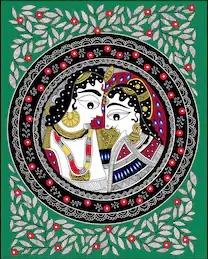WOMEN PAINTERS OF MITHILA- MADHUBANI PAINTINGS
- Chitrini

- Aug 29, 2020
- 3 min read
By Deepthi C S
This piece of art, serving many social causes preserves culture of India, which made me to research more on Indian arts and culture forms. With evolving trends this artform too has evolved but still stands as flag bearer of rich Indian art culture.
The story is about Madhubani paintings, which used to add glory to the mud walls of Bihar & Nepal long back when the modernity was myth. This art form has prevailed for these many years serving the people in all distress including natural calamities. The pride and the culture of Indo-Nepal line- Madhubani paintings.
Madhubani| Origin
Madhubani is said to hail from Trethayug when the King of Mithila-Janak orders to decorate the walls of giant palace on the festive of Princess Sitha’s marriage. Thus, the birth of magnificent art form which has provoked artisans across the globe to nurture this art. It is believed that this art brings luck and prosperity to the newlyweds henceforth can be seen on every mud walls of the village.
Madhubani| Paints & Tools
Women believed that paintings are the best medium to convey their message to the God. Every woman was carving this form of paint on the walls hoping for a perfect partner like one the Goddess Sitha got. Mythological hero-heroines- Krishna, Rama, Radha, Durga, Shiva, Saraswathi etc, sun, moon, tulsi, and also royal court proceedings of the time are depicted in the art. There won’t be any space in paintings, even if the space exists artists will cover it using dazzling flowers, birds, geometric patterns and animals.
Started with painting on the mud walls, now evolved on canvas, paper, clothes, utensils and bangles too. Tools used are brushes, fingers, twigs, pen nibs, other materials made of bamboo sticks.
Color used are natural one-made of powdered rice, natural dyes and plants.
Madhubani Types

1. Kayastha:
This type of madhubani depicts characteristics like fertility and life. Here solo color is used.

2. Bharni:
This type depicts the story of religious characters, Hindu deities such as Radha-Krishna, Shiva, Durga etc.

3. Tattoo:
This type depicts story of Kings, Sun, Moon etc.
Apart from these types there are several styles of madhubani paintings based on the castes like:
1. Bharni, Katchni, Tantrik – by Brahman and Kayasth women who are considered as upper caste.
2. Nepali, Kohbar, Godhna- by Dalit and Dushadhs considered as lower caste.
Madhubani | Timeline of Recognitions:
1949----------
Article featuring Madhubani paintings got published in ‘Marga’- an Indo-Nepal Art Journal by Mr.William G Arch
1966-1968------
Drought had hit severely that economic condition got worsened. During that time the then Director of Indo-Nepal Handicrafts Board, Ms. Pupul Jayakar sent Bombay based artist Mr. Bhaskar Kulkarni to Mithila to encourage artists and earn
1970---------
Yves Vequed, French Novelist & journalist wrote a book on Madhibani paintings, researched and produced film called – The women painters of Mithila
1975--------
Jagdamba Devi, woman artist of Madhubani paintings was awarded with prestigious Padmashri
1977--------
Erika Moser, German anthropologist, film maker & social activist encouraged lower caste of Mithila, Dushadhs to paint and thus emerged Godhna as mentioned earlier
Around 1980-----
Ms. Viji Srinivasan, Programme officer of Ford foundation then nurtured this art through an NGO named Adithi- Headquartered in Bihar.
1981--------
Another woman artist- Sithadevi was awarded with prestigious Padmashri.
Around 1990-----
Japan showed interest on Madhubani paintings and built Mithila museum in Tokamachi, Japan and placed 850 madhubani paintings.
And lot many more till now…
Sources:
2. How to do madhubani paintings: http://lovemadhubani.blogspot.com/
3. Madhubani saving trees: https://www.bbc.com/news/world-asia-india-20422540
5. Picture source: https://www.madhubani.com/about-madhubani-art.aspx









It's unique art of heritage, good info collection, Well-done 👍